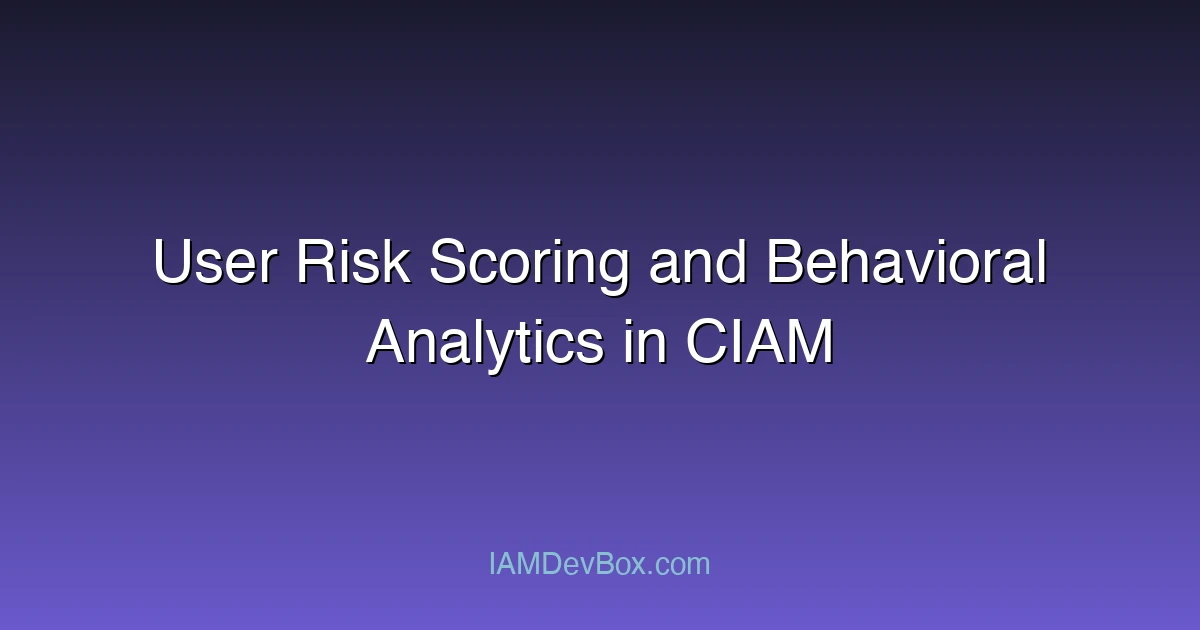Introduction
Visual Overview:
graph TB
subgraph "Authentication Methods"
Auth[Authentication] --> Password[Password]
Auth --> MFA[Multi-Factor]
Auth --> Passwordless[Passwordless]
MFA --> TOTP[TOTP]
MFA --> SMS[SMS OTP]
MFA --> Push[Push Notification]
Passwordless --> FIDO2[FIDO2/WebAuthn]
Passwordless --> Biometric[Biometrics]
Passwordless --> Magic[Magic Link]
end
style Auth fill:#667eea,color:#fff
style MFA fill:#764ba2,color:#fff
style Passwordless fill:#4caf50,color:#fff
In the realm of modern identity management, Customer Identity and Access Management (CIAM) solutions play a pivotal role in securing user interactions while delivering seamless digital experiences. One of the most critical aspects of CIAM is the ability to detect and mitigate risks associated with user behavior. This is where user risk scoring and behavioral analytics come into play.
User risk scoring involves assigning a numerical value to a user based on their behavior patterns, device information, and other contextual factors. Behavioral analytics, on the other hand, focuses on analyzing user actions to identify anomalies that may indicate fraudulent or malicious intent. Together, these techniques enable organizations to proactively detect and respond to potential threats, ensuring a secure and trustworthy environment for users.
In this blog post, we will explore the fundamentals of user risk scoring and behavioral analytics within CIAM, discuss their implementation, and provide real-world examples to illustrate their significance.
The Role of User Risk Scoring in CIAM
User risk scoring is a dynamic process that evaluates the likelihood of a user being a threat. It leverages a combination of factors, including:
- Behavioral Patterns: Deviations from normal user behavior, such as unusual login times or geographic location changes.
- Device and Network Information: Identifying suspicious devices or network configurations that may indicate compromised accounts.
- Contextual Data: Factors like the user’s role, access level, and transaction history.
The scoring system assigns a risk level to each user, which can range from low to high. A high-risk score may trigger additional authentication steps, account lockouts, or alerts to the security team.
Example of Risk Scoring in Action
Consider a user who typically logs in from New York during business hours. If the same user attempts to log in from a remote location in Eastern Europe at an unusual time, the system flags this activity as high-risk. The user may then be prompted to complete multi-factor authentication (MFA) or face account suspension until the issue is resolved.
# Example of a simple risk scoring algorithm
def calculate_risk_score(user_behavior, device_info, context):
risk_score = 0
# Check for unusual login times
if user_behavior['login_time'] < 8 or user_behavior['login_time'] > 18:
risk_score += 5
# Check for geographic anomalies
if device_info['location'] not in user_behavior['usual_locations']:
risk_score += 10
# Check for suspicious device configurations
if device_info['is_rooted'] or device_info['has_malware']:
risk_score += 15
return risk_score
Behavioral Analytics in CIAM
Behavioral analytics goes beyond traditional risk scoring by analyzing user behavior over time to identify subtle patterns that may indicate malicious intent. This approach relies on machine learning models to detect anomalies and predict potential threats.
Key Components of Behavioral Analytics
- Data Collection: Gathering user interaction data, including login attempts, navigation patterns, and transaction history.
- Pattern Recognition: Identifying normal behavior patterns and flagging deviations as potential risks.
- Anomaly Detection: Using statistical models or AI to detect outliers that may indicate fraudulent activity.
Real-World Application: Fraud Detection
A retail banking platform implemented behavioral analytics to detect fraudulent transactions. The system analyzed user behavior, such as the frequency of transactions, the amount transferred, and the time of day. It flagged a user who made a series of small transactions followed by a large, unusual transfer. This pattern was identified as a potential account takeover attempt, and the transaction was blocked in real-time.
Challenges and Considerations
While user risk scoring and behavioral analytics are powerful tools, their implementation comes with several challenges:
- Data Privacy: Ensuring that user data is collected and used in compliance with regulations like GDPR and CCPA.
- False Positives: Minimizing the risk of incorrectly flagging legitimate users as threats.
- Model Accuracy: Continuously refining machine learning models to improve detection accuracy and reduce errors.
Extended Questions for Readers
- How can organizations balance security with user experience when implementing risk-based authentication?
- What are the ethical implications of monitoring user behavior for risk scoring?
- How can small businesses with limited resources implement behavioral analytics effectively?
Conclusion
User risk scoring and behavioral analytics are essential components of a robust CIAM strategy. By leveraging these techniques, organizations can enhance security, minimize fraud, and deliver a frictionless experience to their users. As cyber threats continue to evolve, adopting advanced analytics and machine learning will be critical to staying ahead of potential risks.
By integrating these tools into your CIAM framework, you can create a secure, scalable, and user-centric identity management system that adapts to the ever-changing threat landscape.
